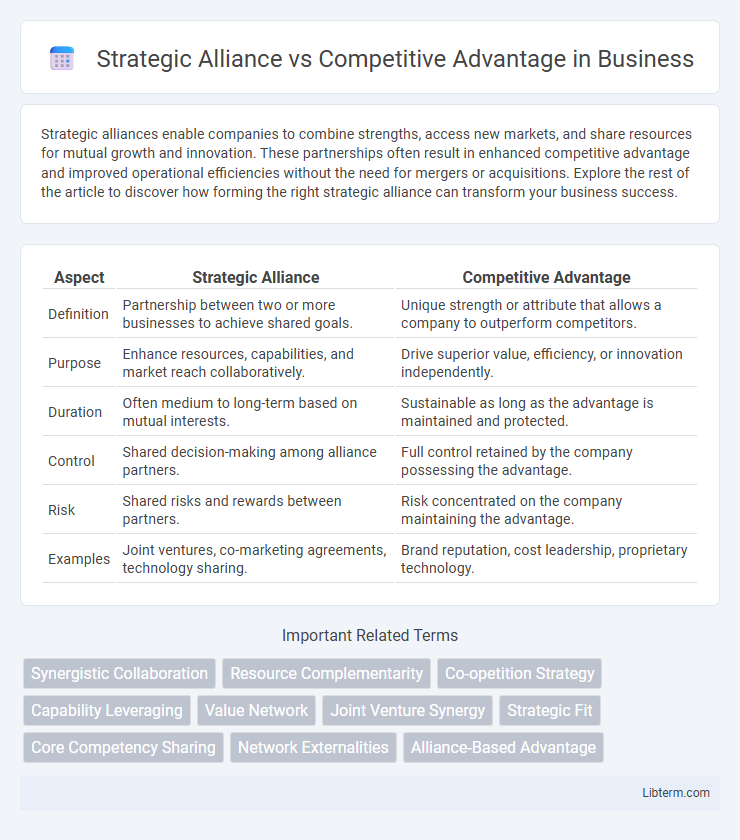Strategic alliances enable companies to combine strengths, access new markets, and share resources for mutual growth and innovation. These partnerships often result in enhanced competitive advantage and improved operational efficiencies without the need for mergers or acquisitions. Explore the rest of the article to discover how forming the right strategic alliance can transform your business success.
Table of Comparison
| Aspect | Strategic Alliance | Competitive Advantage |
|---|---|---|
| Definition | Partnership between two or more businesses to achieve shared goals. | Unique strength or attribute that allows a company to outperform competitors. |
| Purpose | Enhance resources, capabilities, and market reach collaboratively. | Drive superior value, efficiency, or innovation independently. |
| Duration | Often medium to long-term based on mutual interests. | Sustainable as long as the advantage is maintained and protected. |
| Control | Shared decision-making among alliance partners. | Full control retained by the company possessing the advantage. |
| Risk | Shared risks and rewards between partners. | Risk concentrated on the company maintaining the advantage. |
| Examples | Joint ventures, co-marketing agreements, technology sharing. | Brand reputation, cost leadership, proprietary technology. |
Understanding Strategic Alliances
Strategic alliances are collaborative agreements between businesses that combine resources, expertise, and market access to achieve mutual benefits while maintaining independence. Understanding strategic alliances involves recognizing their role in enhancing innovation, expanding geographic reach, reducing costs, and mitigating risks compared to pursuing competitive advantage alone. These partnerships create synergies that can strengthen a company's market position without directly engaging in competition.
Defining Competitive Advantage
Competitive advantage is defined as a firm's ability to outperform rivals by generating greater value through unique resources, capabilities, or positioning in the market. This advantage enables sustained superior profitability by creating barriers to imitation and reinforcing customer loyalty. Unlike strategic alliances, which involve collaboration between firms to share resources or enter markets, competitive advantage centers on internal strengths that provide a distinct and lasting edge over competitors.
Types of Strategic Alliances
Strategic alliances can be categorized into joint ventures, equity alliances, and non-equity alliances, each offering different degrees of resource sharing and control. Joint ventures involve creating a new entity owned by two or more partners, enabling deep collaboration and shared risk, while equity alliances entail one partner taking a stake in another, promoting closer cooperation without forming a new company. Non-equity alliances rely on contractual agreements for collaboration, focusing on specific projects or resource sharing without equity exchange, providing flexibility but limited influence over the partner's decisions.
Sources of Competitive Advantage
Strategic alliances leverage complementary resources and capabilities from partner firms, such as technology, market access, and expertise, to create unique value propositions that are difficult for competitors to imitate. Competitive advantage stems from firm-specific assets like proprietary technology, strong brand equity, cost leadership, or superior customer service that enable sustained above-average performance. Developing dynamic capabilities within alliances enhances innovation and flexibility, strengthening competitive positioning in rapidly changing industries.
Strategic Alliances as a Tool for Gaining Competitive Edge
Strategic alliances enable companies to leverage complementary resources, technologies, and market access, fostering innovation and expanding customer reach. These partnerships create synergies that enhance operational efficiency and reduce costs, providing a sustainable competitive edge over rivals. By combining strengths, firms can rapidly adapt to market changes and capitalize on new opportunities, solidifying their position in the industry.
Key Differences: Strategic Alliance vs Competitive Advantage
Strategic alliances are cooperative agreements between two or more organizations aiming to achieve shared goals by leveraging each other's resources and capabilities. Competitive advantage refers to a firm's ability to outperform rivals by offering greater value through unique resources, cost leadership, or differentiation. The key difference lies in collaboration versus competition: strategic alliances emphasize partnership and resource sharing, while competitive advantage centers on internal strengths that set a company apart in the marketplace.
Benefits and Risks of Strategic Alliances
Strategic alliances offer benefits such as resource sharing, access to new markets, and enhanced innovation potential, which can lead to improved competitive advantages. However, risks include potential conflicts of interest, loss of proprietary information, and dependency on partners that may affect overall business stability. Carefully managing alliances is essential to maximize benefits while mitigating risks that could undermine competitive positioning.
Case Studies: Alliances that Built Competitive Advantage
Case studies such as the alliance between Starbucks and PepsiCo demonstrate how strategic partnerships leverage complementary strengths to create competitive advantages, enabling market expansion and innovation. The collaboration between Apple and IBM highlights how alliances can combine expertise in hardware and enterprise software to disrupt traditional markets and enhance customer value. These examples illustrate that strategic alliances can build sustainable competitive advantage by fostering resource sharing, knowledge exchange, and coordinated market approaches.
Factors Influencing Alliance Success and Competitive Position
Factors influencing alliance success include trust between partners, complementary resources, and aligned strategic goals, which enhance collaboration effectiveness. Competitive advantage is strengthened by leveraging unique capabilities, innovation, and market positioning derived from successful alliances. The competitive position improves when alliances enable access to new markets, technology sharing, and risk reduction, fostering sustainable growth.
Future Trends: Strategic Partnerships and Sustainable Advantage
Strategic alliances increasingly leverage emerging technologies like AI and blockchain to create adaptive, data-driven collaborations that foster innovation and market agility. Future trends emphasize integrating sustainability metrics into partnerships to secure long-term competitive advantage while addressing environmental and social governance (ESG) criteria. Companies adopting these strategic partnerships benefit from shared resources and enhanced resilience, positioning themselves ahead in evolving global markets.
Strategic Alliance Infographic

 libterm.com
libterm.com